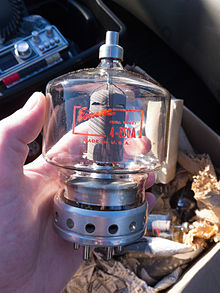
A tetrode is an electronic device having four active electrodes. The term most commonly applies to a two-grid vacuum tube. It has the three electrodes of a triode and an additional screen grid which significantly changes its behavior.
The grid nearest the cathode is the “control grid”; the voltage applied to it causes the anode current to vary. In normal operation, with a resistive load, this varying current will result in varying (AC) voltage measured at the anode. With proper biasing, this voltage will be an amplified (but inverted) version of the AC voltage applied to the control grid, thus the tetrode can provide voltage gain.
The second grid, called “screen grid” provides a screening effect, isolating the control grid from the anode, reducing the parasitic capacitance between the two. This helps to suppress unwanted oscillation. In normal operation the screen grid is connected to a positive voltage, and bypassed to the cathode with a capacitor.
As the screen grid is positively charged, it collects electrons, which causes current to flow in the screen grid circuit. This uses power and heats the screen grid. There are two sources of electrons collected by the screen grid—in addition to the electrons emitted by the cathode, the screen grid can also collect secondary electrons ejected from the anode by the impact of the energetic primary electrons.
Under certain operating conditions, the tetrode exhibits negative resistance due to secondary emission of electrons from the anode (to the screen). In general, if the anode voltage exceeds the screen voltage, this region is avoided, and good performance can be expected.
Click A / B band Pulsed Amplifier or A / B / C Band High Power Pulsed Amplifier for examples of tetrode-based amplifiers built by H6 Systems Inc.
References
References
- Jerry C. Whitaker (ed); The Electronics Handbook, 2nd ed., pages 360, 366, 377, 383, 393-394. (2005).
- L.W. Turner, (ed), Electronics Engineer’s Reference Book, 4th ed. Newnes-Butterworth, London (1976).
(Extracted from Wikipedia.com.)
